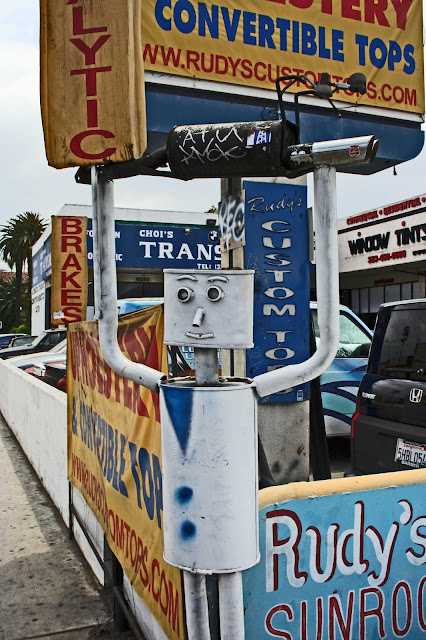One thing that’s confirmed by a walk around the Hollywood Forever
cemetery, down on Santa Monica Boulevard: there is no relation between the size
of a person’s fame and the size of their memorial.
I mean I can, more or less, understand why there’s a large and very
literal statue of Johnny Ramone. It
strikes me as a strange and welcome splash of irony and subversion, though I’m
never entirely sure if that’s intentional: irony and subversion are rather difficult to
pull off in a graveyard.
However, elsewhere in the cemetery is this headstone belonging to one Roman
Kozlov:
Now, the internet reveals a few Roman Kozlovs, one of them is even a
guitarist, but as far as I can tell, it’s not this one. So we note the man and his headstone, and
assume he must have been a guitar aficionado of some kind, and that’s about it. We’re left remembering the headstone rather
than the man. It piques your curiosity,
even as it fails to satisfy it.
The thing that everybody notices at Hollywood Forever is the one in
the shape of an Atlas rocket, the memorial for Carl Morgan Bigsby. It might lead you to think he had something
to do with the space program, but apparently not. The monument says Bigsby was “a
recognized leader in many phases of the graphic arts,” a pioneer, just like the
Atlas rocket, suggesting that we’re dealing with a metaphor here. Trying to track him down online reveals that
he’s most famous for having this very large memorial.

And what about the above remarkably simple and rather moving cross made out
of what appears to be plastic irrigation pipe.
Is this austerity a deliberate rejection of the extravagance all around
it? Was the loved one a gardener, a
plumber? A put the question to my Russian-speaking friends.
Polyglot pal Kevin Kinsella tells me
that "упок
господи" is standard Russian Orthodox tombstone copy. Something like
"Welcome, O my God, Nicholas Vitte", in this case. or "God, meet
Nicholas." And “drozdovets” means that he was White as opposed to Red
Russian. “I think it's like a point of
honor among the emigre community,” says Kevin
My other pal Anna Paton offers, "Upokoj gospodi"
means "Lord give peace" more religious form of R.I.P.
So
still no indication of why the cross is made of plastic pipe.
Hollywood Forever is divided into a series of areas, mostly
designated as "gardens." There’s the Garden of
Memory, the Garden of Eternal Love, the Chandler Garden (no, not Raymond).
And for headliners, there’s the Garden of Legends, that’s where Johnny
Ramone is, and fame being the fleeting thing it is, some of the people buried there are now very obscure, so even having been a legend doesn’t necessarily mean a big memorial. Here for example is the headstone of Virginia Rappe, complete with
tribute footwear:
Poor Virginia really never got a break, a small-time actress and
model, chiefly famous for the circumstances in which she died – of a ruptured
bladder and peritonitis after attending a Fatty Arbuckle party. So you can perhaps understand why the grave
is modest.
On first inspection it looks as though Jayne Mansfield’s headstone
is equally modest too.
And I thought there was something appealing about this, that if
you’ve led a gaudy life, then it’s only appropriate to have a quiet, dignified
headstone. But I was wrong. I discover that the stone in
Hollywood Forever is just a stone. Jayne Mansfield is actually buried in Pennsylvania
in a grave with a huge, heart-shaped headstone.
When I first when to Hollywood Forever, a long time ago now, I was
amazed to see peacocks strutting about the place, but the time before last time
when I went there I didn’t see any at all.
I feared they might be gone, but no, I did see one this time, and also a
peahen.
I also saw, and maybe they were there all along and I never spotted
them before, a colony of cats. I saw half a dozen though there could easily be
more. They look vaguely feral, although more relaxed and less skittish than most feral
cats. Clearly somebody’s feeding and
sheltering them, possibly the same people who feed the peacocks.
To be honest I’m not sure I’ll ever have a grave of my own, and if I do
it almost certainly won’t be in Hollywood Forever, but if I did, I think I should be
very happy to have it surrounded and walked on by graveyards cats.




































